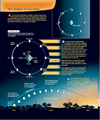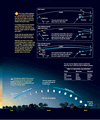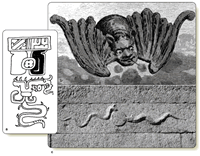|
|
STARTING THIS EVENING, look for the moon in the sky. If the night is cloudy or the moon is in the wrong part of its orbit, you may not see it, but keep trying on successive evenings, and within a week or two you will see the moon. Then watch for the moon on following evenings, and you will see it following its orbit around Earth and cycling through its phases as it has done for billions of years.
If you watch the moon night after night, you will notice two things about its motion. First, you will see it moving eastward against the background of stars; second, you will notice that the markings on its face don’t change. These two observations will help you understand the motion of the moon and the origin of the moon’s phases.
The moon moves rapidly among the constellations. If you watch the moon for just an hour, you can see it move eastward against the background of stars by slightly more than its angular diameter. In the previous chapter, you discovered that the moon is about 0.5° in angular diameter, so it moves eastward a bit more than 0.5° per hour. In 24 hours, it moves 13°. Each night when you look at the moon, you see it about 13° eastward of its location the night before. This eastward movement is the result of the motion of the moon along its orbit around Earth.
The changing shape of the moon as it orbits Earth is one of the most easily observed phenomena in astronomy. Everyone has noticed the full moon rising dramatically or a thin crescent moon hanging in the evening sky. Study The Phases of the Moon on pages 40–41 and notice three important points:
- First, the moon always keeps the same side facing Earth, and you never see the far side of the moon. “The man in the moon” is produced by the familiar features on the moon’s near side.
- Second, the changing shape of the moon as it passes through its cycle of phases is produced by sunlight illuminating different parts of the side of the moon you can see.
- The third thing to notice is the difference between the orbital period of the moon around Earth and the length of the lunar phase cycle. That difference is a good illustration of how your view from Earth is produced by the combined motions of Earth and other heavenly bodies such as the sun and moon.
You can make a moon-phase dial from the middle diagram on page 40 by covering the lower half of the moon’s orbit with a sheet of paper, aligning the edge of the paper to pass through the word “Full” at the left and the word “New” at the right. Push a pin through the edge of the paper at Earth’s North Pole to make a pivot, and under the word “Full” write on the paper “Eastern Horizon.” Under the word “New” write “Western Horizon.” The paper now represents the horizon you see facing south.
You can set your moon-phase dial for a given time by rotating the diagram behind the horizon paper. Set the dial to sunset by turning the diagram until the human figure labeled “sunset” is standing at the top of the Earth globe; the dial shows, for example, that the full moon at sunset would be at the eastern horizon. We Earthlings always see the same side of the moon looking down on us, but the changing shadows make the man in the moon shift his moods as the moon cycles through its phases (Figure 3-2). Watch for the moon and enjoy the cycle of phases. It is one of the perks of living on this planet.
Why is the moon sometimes visible in the daytime?
Lots of people are surprised when they notice the moon in the daytime sky, but you aren’t surprised because you can explain it with a simple scientific argument involving the geometry of the moon’s motion. The full moon rises at sunset and sets at sunrise, so it is visible in the night sky but never in the daytime sky. At other phases, it is possible to see the moon in the daytime. For example, when the moon is a waxing gibbous moon, it rises a few hours before sunset. If you look in the right spot, you can see it in the late afternoon in the southeast sky. It looks pale and washed out because of sunlight in Earth’s atmosphere, but it is quite visible once you notice it. You can also locate the waning gibbous moon in the morning sky. It sets an hour or two after sunrise, so you would look for it in the southwestern sky in the morning.
A simple scientific argument analyzing the motion of the moon can explain a lot about what you see and what you don’t see. Why is it extremely difficult to see the crescent moon in the daytime?
Connections: The phases of the moon don’t affect you directly—you don’t act crazier than usual at full moon. The phases are a decoration in the sky, but occasionally, the moon provides a more dramatic treat.
Figure 3-1
(a) A 12th-century Mayan symbol believed to represent a solar eclipse. The black-and-white sun symbol hangs from a rectangular sky symbol, and a voracious serpent approaches from below. (b) This Chinese representation of a solar eclipse shows a dragon flying in front of the sun. (From the collection of Yerkes Observatory) (c) This wall carving from the ruins of a temple at Vijayanagara in southern India symbolizes a solar eclipse as two snakes approaching the disk of the sun. (T. Scott Smith)

Figure 3-2
In this sequence of the waxing moon, you see the same face of the moon, the same mountains, craters, and plains, but the changing direction of sunlight produces the lunar phases. (UCO/Lick Observatory)


The Phases of the Moon
Ipages 40-41
